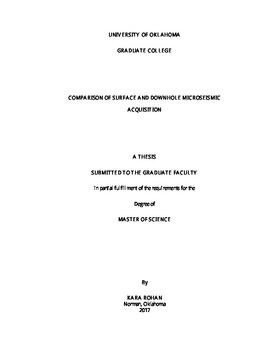| dc.description.abstract | The most common microseismic monitoring methods used in the industry today are by the use of surface arrays and downhole arrays. In surface acquisition, sensors are deployed on the surface in large two-dimensional arrays, allowing this method to provide a greater accuracy in horizontal locations due to the wide aperture it can cover. In contrast, downhole acquisition places the sensors directly in the subsurface, allowing monitoring to be closer to the fracture events, therefore resulting in higher fidelity results.
To address these issues, a high quality microseismic dataset was acquired in the Anadarko Basin, Canadian County, Oklahoma, in January 2013, with its target formation being the Woodford Shale. The final microseismic event catalogues produced 1074 events from a surface array and 6450 events from a downhole array. Through proper alignment of the catalogues and correlation of events by time, 768 events were located by both acquisitions.
Upon analysis of the microseismic events, it was observed that those events recorded by the surface array were systematically shifted too deep compared to the events recorded by the downhole array. The surface events however did appear to be better constrained on lateral location as the events took on a linear pattern, aligned in their expected hydraulic fracture paths. In contrast, the downhole events were much more dispersed laterally. After thorough analysis, the highest quality interpretation was made based on co-identified events.
Because attenuation modifies the seismic velocity, I evaluated it as a possible factor in the difference between each mode of acquisition. The raw dataset of microseismic events were filtered, vector-rotated, and muted prior to Q estimation using a spectral ratio analysis.
The event location ambiguities and difficulties in Q estimation provide insight into the complexity of the downhole waveforms. The signals recorded from the later stages of the hydraulic fracture job were the most difficult signals for arrival time picking. This was due to the amount of noise in the signals from the superposition of head waves and late arrivals, as well as the inconsistency of source signatures among the signals. The Q values obtained from the earlier stages were reasonable, while those from later stages were non-physical, suggesting attenuation and scattering effects associated with irregular ray paths and for some events, propagation through a zone damaged by previous microseismic events. | en_US |
